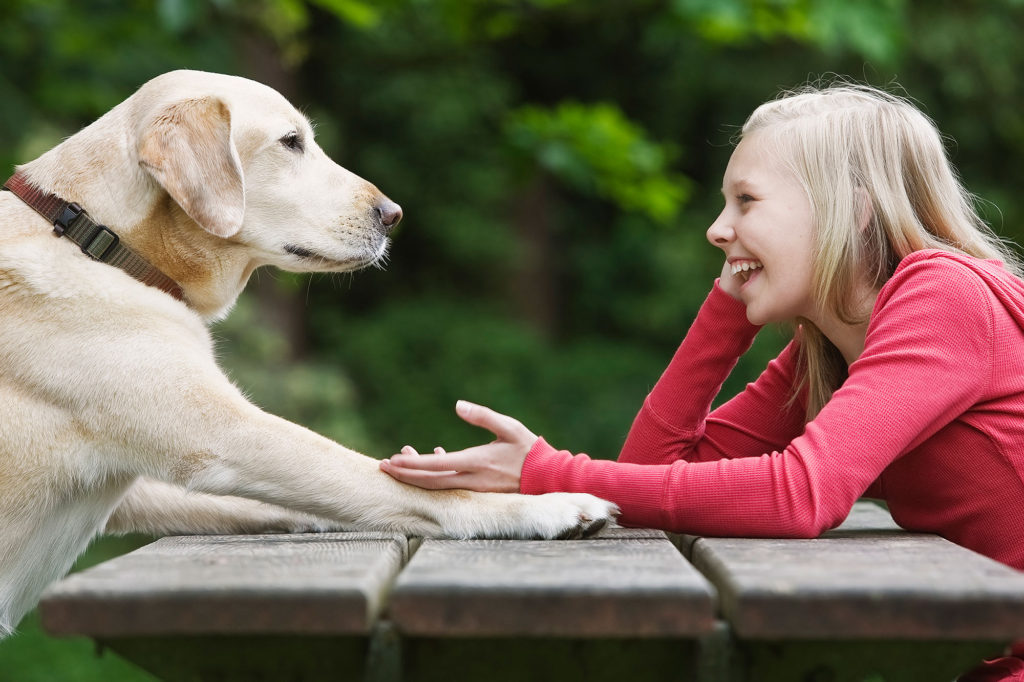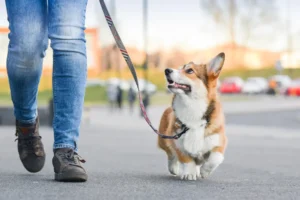THE CORRECT USE OF VOICE COMMANDS FOR TRAINING YOUR DOG
Use Consistent Dog Commands. Once your dog has learned a command, do not vary it. Use it the same way—same tone of voice, exact phrase—every time you give the command. Don’t confuse the dog by saying “Come,” “Come over here,” “Come on, boy,” “Come on, Come on,” etc. Pay attention to what you’re saying and discipline yourself to use the exact phrase every time—and only one at a time. For example, “Come on… sit down… stay… okay?” contains four requests, but not one command that a dog can clearly understand and follow.
Develop a personal dog training vocabulary. Make a dog vocabulary that works for you, one you use consistently to express precisely what you need or mean to say. “Oops” is a wonderful dog training word because it represents a gentle reprimand. By its very nature, “oops” can’t sound angry—it implies “Nope, try again,” rather than the less forgiving “NO!” You can say “oops” when your dog executes the wrong command (like lying down instead of sitting) or ignores you. “Oops” sounds cautionary but forgiving, especially because when you say it you are probably going to give the dog another chance to do your bidding. “Oops” makes you a more forgiving “boss,” which creates a better learning environment for your dog.
Be aware of how you use the word “down,” especially. If “down” means “lie down,” then don’t use it interchangeably to tell a dog not to jump up on people. (“Off” might work, but only if you don’t use it to signal a dog to get off a piece of furniture or get out of a car, which is different.)
Give your dog a command using a consistent tone of voice. How you say a word—the tone, the inflection at the end of the word—must be the same each time for your dog to respond reliably. Changing your tone alters the meaning of the command. You’ll gain control of your voice simply by focusing on it.
QUICK VOICE TIPS FOR TRAINING YOUR DOG
Use a sound or word in a way that helps get the point across:
- Use short, repeated, energetic sounds to encourage activity, such as coming to you.
- Use one long sound to discourage activity (“Noooo”) when the dog is starting to do something forbidden or is in the process of it.
- Use a long sound to soothe your dog at the vet: “Gooood girl.”
- Develop the habit of drawing out the word “Gooood” at the very moment your dog complies with a command. It is a vocal reward that can be attached to a physical reinforcement.
THE PITCH OF YOUR VOICE MATTERS IN DOG TRAINING
Use a low-pitched voice to convey authority. When you command your dog using a low voice, he’ll respond better. Using a low register conveys confidence and seriousness; this is partly because a mother dog growls low and slowly to control her pups. But lower does not mean louder—drop your voice a decibel or two.
A voice teacher would say the sound needs to come from your chest, not your throat (which has a piercing, higher pitch). Women with high-pitched voices can practice sending their voice up from the chest instead of speaking from the upper throat or nasal area. It may sound affected to you at first, but try it at home and get comfortable with a softer pitch. Your voice will sound more pleasant.
If the dog ignores your command to come, remain unemotional about it and say “Noooo” in a low, growly voice. Then say “Come” again in a nice, cheery tone. See what difference the pitch of your voice can make to the dog—and remember this for everyday practice.
Use a higher pitch voice for praise. Men (or women with deep voices) should practice using a higher voice to encourage their dog, even if they feel silly. When you want to encourage your dog to continue what he is doing, you have to think like a cheerleader: use a high-pitched “Come on! That’s a good boy! You can do it!” The most effective trainers make their dogs enthusiastic by using a happy, energetic voice and speaking the dog’s name with high-pitched enthusiasm.
HOW TO AVOID COMMON PROBLEMS WHEN YOU TALK TO YOUR DOG
Dogs don’t speak English, but they possess a large cognitive vocabulary if we take the time to talk to them. It’s true: some dogs really can pick up the sense of what we mean a lot of the time. But don’t confuse this with understanding language the way humans do.
Some people chat a lot to their dogs and get the impression they’re being understood. They assume that when it’s something important they’re trying to get across, their dog should know what they mean. The dog may not respond to what you’re asking for because he is confused about what you want. Dogs can pick up on the routine things we do with them and from the sound of our words and the inflection in our voices, but that does not mean they understand our language, especially in unfamiliar situations.
Your dog’s name is not a command. Remember the phrase, “That’s my name, don’t wear it out!”—the one kids in grade school used when someone called their name? Every time you find yourself trying to communicate with your dog by saying nothing more than his name in a variety of inflections (“Oscar?” “Oscar!”), Just remember the annoying kid at recess.
Our dogs can tune us out if we repeatedly call their names in a wide variety of tones of voice throughout the day. We’re all guilty of this at times, but we’re wasting our breath because a dog can’t read our minds (even though there are times when it seems he can). When all you say is the dog’s name and you’re convinced he still knows exactly what you mean, it’s probably because he’s picking up and responding to visual clues that you don’t even realize you are sending out. Pay attention to your habits and you’ll probably notice that you often call out the dog’s name with an up-inflection, an annoyed tone, a sharp voice, etc., without a command like “come” or “wait” after it.
This lack of clarity can increase a nervous or high-strung dog’s natural anxiety. Another downside to a dog hearing his name repeatedly for no apparent reason is that it desensitizes him to his name. After a while, he may not even react when he hears it. If you persist in saying his name without any meaningful command attached, you are “using up” your dog’s attentiveness. The dog will assume you don’t know what you want and will ignore you.
“No” is not a dog command. “No” doesn’t mean anything—yet we growl and scream it at our dogs. Do you say “No!” over and over, constantly nagging, getting on the dog’s case? Is he doing something wrong? He’ll feel like he’s doing everything wrong, as would you if somebody relentlessly told you “No!”
Remember to praise the good—praise your dog when he stops a misbehavior. Think of the saying about catching more flies with honey: dogs have feelings of self-worth or confidence that can be enhanced or diminished by how you communicate with them; it’s in your hands.
Avoid illogical negative dog commands.“No bark!” or “No pull!” are ludicrous things to say to a dog. First, dogs don’t speak English—much less understand the concept of “not” doing something, especially when that something is a word they haven’t been taught to respond to in the first place.
“Good sit,” said, after a dog sits, also means nothing. If “sit” means “sit down,” then repeating the word “sit” with a meaningless noise before it (“good”) would be confusing at best; the dog already is sitting. That is what’s good. Any further comment with the word sit is a pointless repetition, even in a pleasant tone of voice.
Avoid repeating dog commands. Every dog training manual says not to repeat a command over and over, because you’ll numb the dog to the word(s). We repeat ourselves because we don’t have the count-to-three patience to wait for the dog to respond to what we’ve asked for. It’s like clicking the mouse multiple times (and freezing up the computer) because you can’t wait for the icon to open up.
The concept of patience is a valuable one to keep in mind, not only when interacting with dogs, but also with children, coworkers, and people in the outside world in general. Repeating yourself is a habit you can break by slowing yourself down mentally—your dog will benefit as much from this as you will. With a dog who already has training but is accustomed to your repeated commands, try the following exercise to retrain yourself to say things only once:
- Give your dog a tiny treat so he knows what’s in your hand. Then issue a command.
- WAIT—don’t move.
- Count to thirty—that’s thirty seconds (although it will feel like thirty minutes).
- Say nothing more, and don’t move. Just wait and watch your dog.
- If he executes the command, treat him immediately. If he ignores it, turn away and ignore him. He’ll be shocked (after all, he’s waiting for you to repeat the command over and over rapidly).
- Try the above sequence again. Your dog will eventually get with the program, if not sooner.
Don’t raise your voice to your dog. If he isn’t responding, don’t get frustrated. Raising your voice to get a reaction does nothing—except raise your frustration level while rattling the dog.
UNDERSTANDING HOW DOGS COMMUNICATE DOMINANCE
“Getting dominance over your dog” is a dangerously misunderstood concept. Establishing yourself as pack leader must be undertaken in terms a dog understands. You want the right balance of dominance and submission to exist between you and your dog, so he will accept your training requests and social expectations. The points below illustrate dominance problems that can occur between people and dogs. It’s best to start training your dog only after you’ve spent some time researching these behaviors and thoroughly understand them.
SIGNS OF DOG DOMINANCE
- Pushing his ball into your lap/hand to be thrown (high-ranking dogs initiate play).
- Pushing his head into your lap/hand to be patted.
- Leaning against you (the canine way of showing strength).
- Barking back at you when you give a command.
- Growling even slightly when touched during chewing/eating/sleeping.
- Refusing to release a toy or bone.
- Mouthing your hand when you brush/toenail clip/leash/bathe him.
- Pulling at your clothing.
- Pushing past you in a doorway (higher rank goes first).
- Lying across a doorway (controlling it).
- Lying in a hallway watching human activities (guarding territory).










